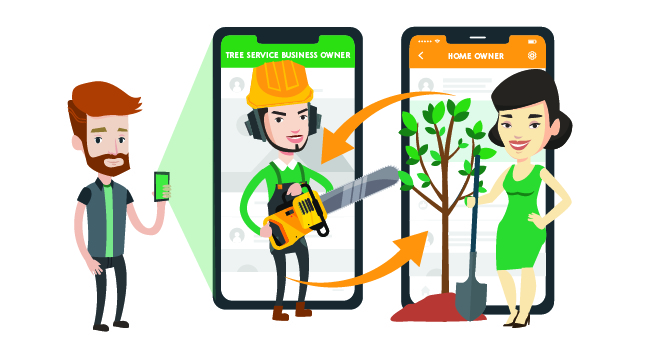Pricing your tree service offerings is a critical aspect of running a successful business. Striking the right balance between profit and competitiveness can help you attract new clients, retain existing ones, and maintain healthy profit margins. In this article, we’ll discuss the key factors to consider when pricing your services, and how partnering with Home Service Direct can help you grow your tree service business.
1. Understand Your Costs
To price your services effectively, you need to have a clear understanding of your costs. These include:
- Labor costs (wages, benefits, and insurance)
- Equipment costs (purchase, maintenance, and depreciation)
- Overhead costs (rent, utilities, office expenses, and insurance)
- Marketing and advertising costs (such as Google Ads and Facebook Ads)
Knowing your costs will help you set a minimum price for your services that covers all expenses while generating a profit.
2. Research Your Competition
Conduct market research to identify your main competitors and their pricing strategies. This can help you understand the current market rates and determine how to position your business within the competitive landscape. It’s essential not to underprice your services just to compete on price, as this can lead to low-profit margins and unsustainable business growth.
3. Determine Your Unique Value Proposition
Your unique value proposition (UVP) is what sets your tree service apart from competitors. It could be your experience, quality of work, customer service, or specialized services you offer. Once you have identified your UVP, use it to justify a higher price for your services. Communicate this value to potential customers through your marketing efforts and tree service website.
4. Choose a Pricing Strategy
There are several pricing strategies you can consider for your tree service business:
Cost-Plus Pricing
Add a profit margin to your total costs to determine the price. This strategy ensures you cover all expenses and generate a profit, but it may not always be competitive in the market.
Competitive Pricing
Price your services in line with your competitors’ rates. This can help you stay competitive, but you need to ensure your costs are low enough to maintain healthy profit margins.
Value-Based Pricing
Price your services based on the value they provide to customers. This strategy allows you to charge higher rates for services that deliver more value, such as specialized or high-quality work.
5. Offer Tiered Services and Packages
Offering tiered services and packages can help you cater to different customer segments and budget ranges. For example, you can offer a basic tree trimming package, an intermediate package that includes trimming and pruning, and a premium package that includes tree trimming, pruning, and tree removal. This approach can help you convert leads into customers by providing options that cater to their specific needs and budgets.
6. Factor in Regional and Seasonal Variations
Consider regional and seasonal variations when pricing your services. In some areas, tree services may be in higher demand due to weather conditions, leading to higher prices. Additionally, during busy seasons, you may need to increase your prices to account for increased labor costs and equipment usage.
7. Monitor and Adjust Your Pricing
Regularly review and adjust your pricing strategy based on market conditions, customer feedback, and your business performance. Track your tree service leads and closing rates to determine if your pricing is effective in generating new business. Don’t be afraid to make adjustments if your current pricing is not yielding the desired results.
8. Leverage Online Marketing and SEO
An effective online marketing strategy can help you reach more potential customers and justify higher prices for your services. Invest in local SEO and tree service SEO to improve your online visibility and attract customers who are willing to pay for quality services.
Additionally, consider using pay-per-click advertising to target customers actively searching for tree services in your area. Home Service Direct can help you optimize your PPC campaigns and generate high-quality leads.
9. Offer Incentives and Discounts
Offering incentives and discounts can help you attract new customers and encourage repeat business. For example, you can offer a discount for first-time customers, a referral discount for existing customers, or a loyalty program that rewards frequent customers. Be cautious when offering discounts, though – make sure they don’t negatively impact your profit margins or devalue your services.
10. Provide Exceptional Customer Service
Providing excellent customer service can help you justify higher prices for your tree services. Customers are more likely to pay a premium for a company that is reliable, professional, and responsive to their needs. Focus on improving your lead nurture process and providing exceptional service throughout the customer journey.
Tree Service Business Pricing FAQs
How much should I charge to top a tree?
The cost of topping a tree depends on factors such as the tree’s size and location, the job’s complexity, and local labor rates. On average, tree topping can cost between $200 and $1,000 or more per tree. It’s essential to consider the time, labor, and equipment costs involved when determining your pricing. However, it’s worth noting that tree topping is a controversial practice that can harm the health and structural integrity of the tree. Alternatively, consider offering professional pruning services that promote healthy tree growth and maintain a tree’s natural shape.
How Much Does a Tree Care Business Make?
The income generated by a tree care business can vary greatly depending on factors such as location, demand for services, competition, and the size of the business. On average, a small to medium-sized tree care business can generate annual revenues between $100,000 and $500,000. More established businesses with a larger client base and expanded service offerings can earn over $1 million annually.
What is the profit margin for a tree service business?
The profit margin for a tree service business can range from 10% to 30% or higher, depending on factors such as the efficiency of operations, pricing strategy, and overall business expenses. Keeping labor and equipment costs in check, effectively marketing your services, and providing value-added offerings, such as specialized arborist services, can help improve your profit margin. Monitoring your business expenses, optimizing your service pricing, and streamlining operations can contribute to a healthier bottom line and higher profit margins for your tree service business.
Partner with Home Service Direct for Marketing and Lead Generation Support
Successfully pricing your tree service offerings requires a solid understanding of your costs, competition, and value proposition. By partnering with Home Service Direct, you can access expert support for your marketing and lead generation efforts. Our team can help you optimize your online presence, generate high-quality tree service leads, and convert leads into customers, ensuring the sustainable growth of your tree service business.
To learn more about how Home Service Direct can help you price your services effectively and grow your business, get in touch with our team today.








